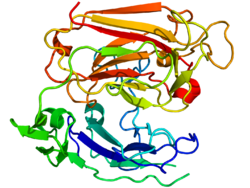Reelin
| Reelin | ||
|---|---|---|

|
||
| Ribbon model of the Reelin fragment from mouse (AS 1222–1597) according to PDB 2DDU | ||
| Properties of human protein | ||
| Mass / length primary structure | 3435 amino acids; 386 kDa | |
| Isoforms | 2 | |
| Identifier | ||
| Gene names | RELN ; RL | |
| External IDs | ||
| Enzyme classification | ||
| EC, category | 3.4.21. , Serine protease | |
| Occurrence | ||
| Parent taxon | Euteleostomi | |
| Orthologue | ||
| human | mouse | |
| Entrez | 5649 | 19699 |
| Ensemble | ENSG00000189056 | ENSMUSG00000042453 |
| UniProt | P78509 | Q148P9 |
| Refseq (mRNA) | NM_005045 | NM_011261 |
| Refseq (protein) | NP_005036 | NP_035391 |
| Gene locus | Chr 7: 102.9 - 103.42 Mb | Chr 5: 21.4 - 21.86 Mb |
| PubMed search | 5649 |
19699
|
Reelin is a glycoprotein that is involved in the differentiation and migration of neurons in the mammalian CNS .
It is of decisive importance, for example, for the maturation of the hippocampus , where the sharp stratification of different neurons is essential for its functionality. There it is formed by Cajal-Rezius cells. For Reelin previously two are receptors known that were previously only of the lipid - metabolism knew. One is the apolipoprotein receptor 2 (APOER2) and the other is the very low density lipoprotein (VLDLR) receptor . Very little is known about the differences between the two.
In reelin knock-out mice ( Reeler mice ), although viable, the unguided cell migration can be clearly seen in sections of the hippocampus and neocortex, which can be partially directed again in co-cultures with reelin-producing hippocampi.
Clinical significance
Disorders of the Reelin availability are associated with the following diseases:
- Norman Roberts Syndrome
- schizophrenia
- Bipolar disorder
- autism
- Temporal lobe epilepsy
- Alzheimer's disease
Individual evidence
- ↑ Lissencephaly syndrome, Norman-Roberts type. In: Orphanet (Rare Disease Database).
- ↑ a b c K. Ishii, KI Kubo, K. Nakajima: Reelin and Neuropsychiatric Disorders. In: Frontiers in cellular neuroscience. Vol. 10, 2016, p. 229, doi : 10.3389 / fncel.2016.00229 , PMID 27803648 , PMC 5067484 (free full text) (review)
- ↑ E. Dazzo, M. Fanciulli, E. Serioli, G. Minervini, P. Pulitano, S. Binelli, C. Di Bonaventura, C. Luisi, E. Pasini, S. Striano, P. Striano, G. Coppola, A. Chiavegato, S. Radovic, A. Spadotto, S. Uzzau, A. La Neve, AT Giallonardo, O. Mecarelli, SC Tosatto, R. Ottman, R. Michelucci, C. Nobile: Heterozygous reelin mutations cause autosomal dominant lateral temporal epilepsy. In: American Journal of Human Genetics . Vol. 96, No. 6, June 2015, pp. 992–1000, doi : 10.1016 / j.ajhg.2015.04.020 , PMID 26046367 , PMC 4457960 (free full text).
- ↑ A. Botella-López, F. Burgaya, R. Gavín, MS García-Ayllón, E. Gómez-Tortosa, J. Peña-Casanova, JM Ureña, JA Del Río, R. Blesa, E. Soriano, J. Sáez -Valero: Reelin expression and glycosylation patterns are altered in Alzheimer's disease. In: Proceedings of the National Academy of Sciences . Vol. 103, No. 14, April 2006, pp. 5573-5578, doi : 10.1073 / pnas.0601279103 , PMID 16567613 , PMC 1414634 (free full text).
literature
Forster, E. et al. (2006): Laminating the hippocampus. In: Nat. Rev. Neurosci. 7 (4): 259-267. PMID 16543914 doi: 10.1038 / nrn1882 PDF
